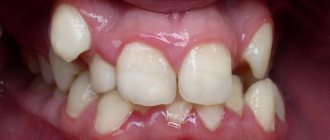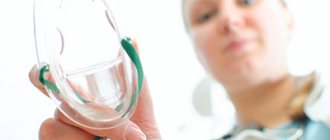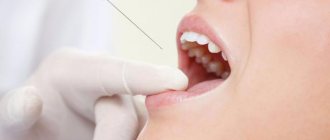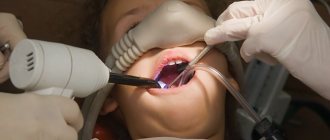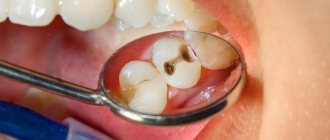The main advantages of dental treatment under anesthesia are that all manipulations can be performed in one visit, and the person will not experience stress. Indeed, due to the lack of emotional reaction of the patient and reduced salivation under general anesthesia, the doctor can carry out treatment to a much greater extent than using local anesthesia. But the fact is that some dental problems cannot be cured in one visit due to objective reasons. In what cases is general anesthesia in dentistry advisable and what risks may occur?
Types of combined anesthesia
- Neuroleptanelgesia. The method involves a combination of antipsychotic and narcotic drugs. In this case, antipsychotics have an inhibitory effect on the nervous system, and narcotic substances enhance the analgesic effect. The drugs most often used are: etapyrazine, aminazine, droperidol and haloperidol;
- Intubation anesthesia. The substance enters the respiratory system using a laryngeal mask. Due to its complexity, this method is also not used often.
Ataralgesia. The combination of analgesics and tranquilizers gives a calming, relaxing and analgesic effect. The most commonly used tranquilizer components are: Relanium, Elenium, Phenazepam and Grandaxin.
Advantages
Of course, the main advantage of general anesthesia is the complete absence of any patient movements, which lengthen the operation and complicate the doctor’s actions. In addition to this fact, there are a number of other advantages of dental treatment in a completely unconscious position, that is, the following:
- relevant for super-traumatic procedures, the patient does not feel compression, vibrations or other tactile stimuli at all;
- absence of any pain after the procedure, which is due to the long residual presence of the drug in the blood;
- minimizing the risk of postoperative complications, since the doctor is not distracted by the patient’s reaction, which can be quite different if anesthesia or at least sedation is not used;
- decreased saliva production, which is ensured by special medications;
Despite all the advantages of general anesthesia, its use is indicated only in certain cases, in contrast to sedation, which is used at the request of the patient in the dental office, even when the procedure is minimally invasive.
Important! When performing sedation (not anesthesia), the anesthesiologist always ensures maximum psycho-emotional comfort, since he excludes specific micro-irritants from the child’s memory: white coats, smells of the dental operating room, noise effects, medical sounds and visual stimuli;
Under sedation, it is possible to perform any full-scale operation to restore the dentition (bone grafting, ENT surgery, implantation using sinus lift surgery, prosthetics).
Introduction of anesthesia: step-by-step description
- Introduction to a state of anesthesia.
- Analgesia. The duration of the stage is approximately 4-5 minutes. At this time, the patient's pain sensitivity decreases, but all reflexes and stable body temperature are preserved.
- Excitation. The duration of the stage is 7 minutes. During this period, the following are observed: instability of pulse and temperature, increased salivation and muscle tone.
- Maintaining anesthesia. This stage is conditionally divided into several stages-levels:
- Surface. The following are noted: normalization of pulse and pressure, muscle tone with complete blocking of sensitivity;
- Easy. Characterized by rhythmic breathing and muscle relaxation. At this point, the doctor can already begin initial, superficial manipulations;
- Full anesthesia. There is complete relaxation of the muscles, rhythmicity of the pulse and breathing, and a slight decrease in blood pressure;
- Ultra-deep anesthesia. Characterized by shallow breathing, weak pulse and low blood pressure.
After completing the manipulations, the supply of the anesthetic substance is stopped and it is replaced with pure oxygen for 2-3 minutes. It is during this interval that the patient awakens, and after 30 minutes his complete recovery is observed.
Concept of general anesthesia
General anesthesia also involves the professional actions of an anesthesiologist aimed at artificially introducing the patient into a state of deep sleep with the help of potent drugs used only in anesthesiology. At the same time, the activity of the central nervous system is reduced as much as possible, which is accompanied by a complete absence of pain, any reaction to irritating factors and partial elimination of reflexes. It could be a narcotic drug.
No matter how sad it may sound, at present, general anesthesia with mandatory hospitalization is now mainly carried out only in public clinics, motivated to retain the patient for several days to simulate statistics with a huge hospital load on “bed-days” and the formation of a bonus fund doctors, as these are the rules now.
However, time does not stand still and now a modern operating room in a specialized non-state dental clinic, which involves the use of general anesthesia in its work, is always provided with the following medical attributes:
- artificial lung ventilation device;
- availability of centralized oxygen supply;
- laryngoscopes, blades of various sizes and endotracheal tubes of all sizes;
- monitors for continuous monitoring of all vital signs, that is, blood pressure, heart rate and blood oxygen saturation (saturation);
- subclavian catheters and related accessories;
- defibrillator and never need it again;
- drugs to provide emergency assistance in the event of any acute situations, which is more likely during general anesthesia (adrenaline, atropine, refortan, stabizol, dopamine, mezaton);
- medical equipment that ensures comfortable work for the anesthesiologist (manipulation table, fluorescent lamp, infusion pump, disposable consumables, intravenous catheters, disposable systems in sufficient quantities).
The main nuances and disadvantages of treatment under general anesthesia
There are a number of disadvantages in the question “ is it possible to treat teeth under general anesthesia ”:
- There is an increased load on the pulmonary and cardiovascular systems;
- Post-anesthesia symptoms are common: nausea, vomiting and weakness;
- Due to limited time, it is possible that the selection of filling material is insufficiently high-quality and the treatment process is disrupted, which consists in the impossibility of preserving the anatomical forms of the tooth being restored.
All manipulations when working with general anesthesia are carried out by: a dentist, a nurse and an anesthesiologist. Throughout the procedure, the operation of all vital systems is constantly monitored.
Expert opinion
Emir Romanovich Omerelli
Maxillofacial surgeon, implantologist
Experience: more than 13 years
To exclude the development of complications, before starting treatment it is necessary to conduct a thorough examination: ECG, X-ray of the lungs, consultations, if necessary, with a therapist, cardiologist and other doctors, collection of blood tests. All this is important to fully assess the patient’s condition and select the optimal type and drug of anesthesia.
They are as follows:
- Mask (inhalation), which is carried out by the patient inhaling a mixture of oxygen and anesthetic gases through a mask. This type of anesthesia is often given to children;
- Intravenous. By introducing anesthetic drugs into the blood.
Dental procedures that can be performed under general anesthesia:
- Removal of a tooth cyst;
- Removal of several wisdom teeth;
- Multiple dental implants.
Premedications
- Sedatives of plant origin (Corvalol, tinctures of motherwort and valerian). Necessary to reduce excitability.
- Neuroleptics (droperidine).
- Anticholinergic drugs.
- Opioid drugs (promedol and morphine).
The selection of the listed drugs is made by the attending physician, based on the specific situation and individual characteristics of the small patient. There must be a compelling reason to use general anesthesia in children.
Possible complications during general anesthesia
There are many side effects of general anesthesia. Sometimes, even in the absence of contraindications, the body's reaction to an anesthetic can be unpredictable, so anesthesia is always a risk. The following complications may occur:
- Decreased cognitive function of the brain;
- Difficult recovery from anesthesia, prolonged confusion;
- Dizziness;
- Nausea and urge to vomit;
- Strong headache;
- Muscle pain;
- Injury to the oral cavity (tongue, teeth, lips);
- Respiratory tract infection;
- Severe brain damage, death (the percentage of cases is minimal).
Is it possible to remove teeth under general anesthesia?
Tooth extraction under general anesthesia requires compliance with all the previously listed measures and is carried out taking into account all individual nuances. Contraindications are given the greatest attention. If there is an excess of possible risks over the expected benefits, the use of general anesthesia is replaced by other measures.
Purpose of general anesthesia in dentistry
General anesthesia is a rather complex and highly responsible intervention in the human body, and therefore requires fundamental knowledge and experience of a highly qualified specialist, modern technical and drug support, as well as appropriate hospital conditions.
All dental clinics that plan to conduct any types of treatment under anesthesia must have a license to provide these services. Ideally, general anesthesia should only be used in a hospital setting, with an intensive care unit or ward available in case of any complications.
The task of the anesthesiologist is to provide the following conditions to the patient:
- analgesia;
- amnesia;
- neurovegetative protection;
- the most convenient conditions for performing dental procedures that are invasive and traumatic.
The anesthesiologist's first priority is always maximum patient safety, avoiding complications and preventing the consequences of anesthesia. It should be remembered that general anesthesia is always associated with a certain percentage of risk, although in modern practice it is extremely small.
Preparation for the procedure
Are you planning to remove or treat root canals with the introduction of medicinal sleep? Be sure to stop eating food 6 hours and water 4 hours before your visit to the doctor. Any manipulation is preceded by a detailed consultation with an anesthesiologist, who must be notified of any chronic diseases, past illnesses, allergic reactions, intolerance to certain drugs.
Immediately after the procedure, you are prohibited from driving. Moreover, most good clinics provide such treatment only if the patient has an accompanying person.
Reasons for using general anesthesia
There are many reasons why a person may need general anesthesia for dental procedures.
Children's fear of going to the dentist
Firstly, children of preschool age often refuse to interact with the dentist out of fear, and due to their age, it is not possible to consciously persuade them to endure the procedure.
Adult fear of dentistry
Secondly, many people experience an irrational fear of dental procedures, instruments, and doctors in general. In this case, even ordinary brushing of teeth turns into moral torture for them, and there is no need to talk about the sounds of a drill.
Medical indications for the use of general anesthesia
Thirdly, medical indications sometimes require the use of general anesthesia. These include:
- multiple tooth extractions, orthopedic and other work-intensive procedures;
- increased gag reflex;
- extremely low pain sensitivity threshold;
- severe tachycardia and other heart diseases;
- allergic reactions to local anesthetic drugs.
If you know that there are indications for general anesthesia, then first of all, consult a good doctor, and together you will find the optimal solution.
The composition of some modern local anesthetics:
- lidocaine (xylocaine) in carpules - contains lidocaine, methylparaben, sodium chloride;
- xylostesin F-forte in carpules – contains lidocaine, norepinephrine hydrochloride, anhydrous carbonic sulfite, carbonic chloride;
- xylocaine MPF – sterile pyrogen-free solution without methylparaben (in carpules);
- xylocaine in vials - contains methylparaben;
- xylocaine MPF with epinephrine - sterile pyrogen-free solution contains xylocaine, epinephrine, sodium metabisulfite, citric acid;
- mepivacaine (mepidont, mevirin, mepivastezin, scan-dicaine, scandonest) – without the addition of vasoconstrictors, sulfites, parabens;
- ultracaine in carpules – contains articaine, adrenaline (0.006), sodium disulfite, methylparaben;
- ultracaine Dc forte – contains articaine, adrenaline (0.012) and sodium disulfite;
- septanest – contains sulfites, EDTA, does not include parabens;
- ubistezin, ubistezin forte (based on articaine, do not contain parabens, but contain sulfites as a preservative).
A revolutionary method of anesthesia - sedation
Positive effects of the drug on the patient
One of the most modern methods is sedation. The patient is immersed under the influence of drugs in a special state, but remains conscious and exhibits normal reflexes.
Drugs are turned off:
- painful sensations,
- fears,
- anxiety,
- and at this time the person seems to be in a dream.
After the operation, he does not remember its details, but quickly comes to his senses and can go home in just an hour. Doctors only recommend not going to work on this day.
The anesthesiologist’s task is to choose the right dose for a particular case, because modern drugs are very strong.
Painless effects of anesthesia
This type of general anesthesia does not affect health, does not depress breathing, and is eliminated from the body very quickly. But the consequences of the operations are much milder, that is, the patient will not experience paresthesia (a feeling of numbness familiar to us all from local anesthesia).
No pain after dental treatment
Postoperative pain, which often occurs during tooth extraction and complex treatment, will become much less noticeable. In addition, such anesthesia is cheaper than standard deep one.
What painkillers can be used during pregnancy?
The use of general anesthesia is strictly contraindicated for pregnant women. During pregnancy, only local anesthesia is allowed. You can give painkilling injections in the following cases:
- With the correct selection of anesthetic and the absence of individual intolerance or allergies to the components of the drug.
- In the absence of adrenaline in the composition of the drug. Many anesthetics contain adrenaline, which leads to vasoconstriction. An increase in the concentration of adrenaline in a pregnant woman can lead to an increase in uterine tone and the risk of premature onset of labor.
- It is not recommended to give pain-relieving injections using Lidocaine. This drug is absorbed quite well and can easily penetrate the placenta into the child’s body.
Some of the safest painkillers used by dentists when treating the teeth of pregnant women are the drugs Ultracaine and Primacaine. These are special anesthetics that do not contain adrenaline and are not absorbed into the placenta, therefore they pose minimal risk to the baby’s health. There are other safe means. An experienced dentist will be able to select a drug depending on the individual characteristics of the patient.
If a pregnant woman is afraid of pain-relieving injections, you can pre-treat the gum area with a special gel.
Indications
Dental sedation is indicated in a state of increased excitability, fear of treatment, but is not limited to this. This method must be used if there is:
- strongly expressed gag reflex;
- mental problems that exclude interaction with the patient;
- traumatic manipulations.
Like any medical intervention, mind control using medicinal methods requires careful preparation. The decision is made by the doctor taking into account all the data.


